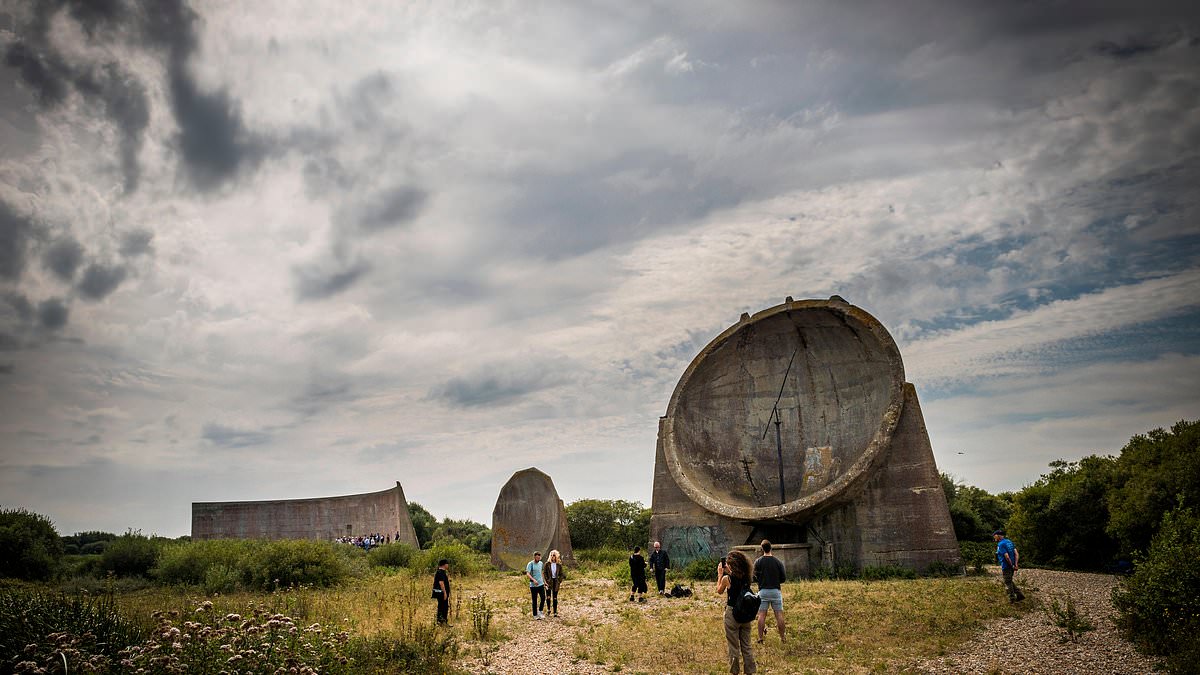QUESTION: Were concrete acoustic ears, built to capture the sound of aircraft, effective?
Some of these acoustic ears or ‘sound mirrors’ date from the First World War. Notable surviving examples include those at Sunderland, Redcar, Denge and Hythe in Kent.
They were not a success. Operators found it difficult to distinguish between aircraft and ships and they were superseded by radar in 1935, before being abandoned in 1939.
Before radar, nations relied on sound to detect incoming aircraft. Devices such as acoustic horns and parabolic sound mirrors were developed during the First World War to amplify and locate the noise of aeroplane engines.
The first use of this type of equipment in Britain is attributed to Alfred Rawlinson of the Royal Naval Volunteer Reserve who, in the autumn of 1916 was commanding a mobile anti-aircraft battery in Norfolk. In order to locate zeppelins during the night or in overcast conditions, he improvised a listening apparatus from a pair of gramophone trumpets mounted on a rotating pole.
In France, physicist Jean Perrin produced an extraordinary device called the Perrin Telesitemeter. This consisted of two ‘myriaphones’, giant ‘ears’ made up of dozens of horns in a honeycomb-likestructure, connected to tubes which could pinpoint soundwaves.
Many of the acoustic ears on England’s south coast were built between 1927 and 1930 under the direction of their inventor, William Sansome Tucker.
They came in various forms. For instance, at Denge there were three mirrors: a large 30ft-wide parabolic circular mirror; a smaller 20ft-wide parabolic mirror; and a 200ft-wide wall. Their shape allowed for sound waves over the English Channel to be collected and magnified towards a hot-wire microphone, also designed by Tucker.
These microphones operated by picking up changes in the resistance of a hot wire as a result of the cooling or heating effects associated with the presence of a sound wave.
Q: When and why did the oil company Shell get its name?
Amanda James, Cullompton, Devon
Q: What was the story of John Tawell, the first criminal to be arrested as a result of a telegraph message?
John Rice, Nottingham
Q: Was Christianity once the dominant religion in Egypt?
Sharon Colman, Warlingham, Surrey
The acoustic ears made it possible for listeners to detect incoming enemy aircraft around 15 or 20 minutes earlier than before. Some were even able to detect aircraft up to 25 miles away.
However, they were not effective. The operators could only function for about 40 minutes at a time, and the devices were quickly rendered obsolete as airships were replaced by aircraft, speeds increased and the warning provided by the mirrors reduced accordingly.
The first practical radar system was invented by Scottish physicist Sir Robert Watson-Watt in 1935 and allowed aircraft to be detected as far as 90 miles away.
A few years later, a chain of radar stations was established throughout England, which helped defend the British and played a crucial role in the Allied victory during the Second World War.
Russell Davies, St Albans, Hertfordshire
QUESTION Which town or city in Britain boasts the cheapest pint? And the most expensive?
According to a 2024 study based on average prices for the lowest-cost draught lager, the three cheapest pints in the UK could be found in Bangor (£2.63), Wrexham (£3.04) and Preston (£3.16).
Unsurprisingly, London had the most expensive pint in the country at £5.88, followed by Edinburgh (£5.84) and Buckingham (£5.45).
Sam Morris, Wolverhampton
QUESTION Why was MP and diarist Henry Channon called ‘Chips’?
Born in Chicago in March 1897, Henry ‘Chips’ Channon settled in England after the First World War.
He married into the wealthy Guinness family (Lady Honor Guinness, in 1933) and served as Conservative MP for Southend from 1935 until his death in 1958.
His political career was unremarkable but his diaries were quite the opposite: elegant, gossipy, bitchy and downright scandalous – they are a classic of the genre.
His nickname remains a source of mystery. It looks to originate from his time at Christ Church, Oxford.
His biographer, Richard Carreno, states: ‘The often-recited tale that Channon roomed with a young man named “Fish” (creating a “Fish and Chips” duo) has more substance. The name was colourful, stylish and evinced a kind of cheeky flavour of a Society rake; just right for this newly minted “Chips”. ’
Another story was that Channon would serve potato chips at his cocktail parties in the US, but this appears unlikely.
It seems remarkable that in more than three million words of diaries, Channon never discussed his nickname once.
Catherine Peel, Malvern, Worcs
